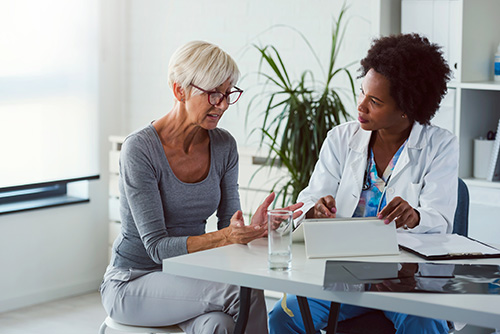Authored by Dr. Sarika Arora, MD
Women with the most common form of breast cancer may find that their treatment plans include tamoxifen. Tamoxifen is one of the most frequently-used chemotherapy drugs though it is somewhat controversial.
When it comes to any kind of breast cancer chemotherapy, there’s a lot to think about. If you have a high-risk profile for breast cancer, or if you’ve been diagnosed with the disease, you may be asking, “Do I need to take tamoxifen?”

What is tamoxifen?
Tamoxifen has been in use for a long time — over 30 years. It is classified as a selective estrogen receptor modulator or SERM. Tamoxifen and raloxifene, a similar drug, are the only medications to be FDA-approved for prevention of breast cancer in women who are at higher risk because of familial risk factors. Only tamoxifen can be used for prevention in all women, and raloxifene can only be used in postmenopausal women. Tamoxifen has also been used as a primary treatment for some early stage forms of cancer and as a secondary, or adjuvant (supportive), treatment in more advanced cancers.
SERMs like tamoxifen are endocrine therapies, meaning they affect how hormones work. SERMs work by blocking the effects of estrogen in the body’s tissues. Other endocrine therapies suppress the body’s production of estrogen in various ways. Since 70% to 80% of breast cancers are estrogen receptor-positive — they grow in response to the presence of estrogen — tamoxifen and other endocrine therapies are used to treat the majority of breast cancers that develop in women.
What is tamoxifen used for?
Tamoxifen is often used for breast cancer prevention in high-risk women. This includes both women with family-related risk factors who’ve never had cancer, as well as women who’ve already had a lumpectomy or mastectomy for a previous estrogen-receptor positive cancer. In this group, tamoxifen is used to prevent cancer from spreading or recurring. Tamoxifen is also used regularly to treat early-stage cancers, such as ductal carcinoma in situ (DCIS), particularly in younger women who seem to tolerate it better.
When it comes to advanced, later-stage cancers, tamoxifen isn’t usually the first option because it is less effective and has more unpleasant side effects than some newer drugs. However, if newer drugs aren’t enough, tamoxifen can sometimes be added, or used alongside radiation therapy and surgery to treat advanced breast cancer.
In addition, women who have completed cancer treatment may be offered tamoxifen as “maintenance chemotherapy” to prevent recurrence, over the course of about 5 years. However, new genetic tests target the tumors themselves to help determine who needs this maintenance chemo and who doesn’t. About 15% of tumors are unlikely to come back even without tamoxifen treatment and that’s good news for women!
The pros and cons of using tamoxifen
Tamoxifen is a well-known drug that has been used in cancer treatment for decades. One of its positives is that there aren’t many unanswered questions about how it works and what women can expect if they take it. When it comes to preventive uses, tamoxifen has a good track record of substantially reducing new or recurrent cancer in women with high levels of cancer risk.
Another positive is its cost. As an older drug, tamoxifen is available in generic form, so it is likely to be less expensive than some newer medications. That may be important if your insurance doesn’t pay for the full cost of treatment.
But there are key drawbacks to tamoxifen: its side effects. Like other endocrine therapies, tamoxifen can cause women who haven’t yet gone through menopause to experience menopausal symptoms, like hot flashes, vaginal dryness or discharge, weight gain, fatigue or insomnia, mood changes, and bone loss, among others.
And there are a few serious possible side effects to tamoxifen that other endocrine therapies, such as aromatase inhibitors like anastrozole (Arimidex), do not share. Side effects include increased risk of blood clots in the lungs and legs, stroke, and endometrial and uterine cancers. These risks can be particularly concerning for a woman who already has a personal or family history of any of these disorders. She and her healthcare provider might want to consider other options.
Another potential problem is liver-related. The liver enzyme, cytochrome P450 2D6 or CYP2D6 for short, that breaks tamoxifen down into its active forms is suppressed by common medications that many woman may be taking. These include serotonin selective reuptake inhibitors (SSRIs) used for depression, like paroxetine (Paxil) and sertraline (Zoloft), and the antihistamine diphenhydramine (Benadryl), which is found in many over-the-counter sleep aids and allergy medicines.
If you’re prescribed tamoxifen, it’s important to discuss any medications you use, even if you only use them occasionally, to make sure they won’t interfere with its activity.
Are there other reasons to avoid tamoxifen?
There are some women who shouldn’t use tamoxifen at all, because the harms outweigh the risks. If you’re weighing this choice, consider these issues:
- If your cancer is not estrogen-receptor positive, tamoxifen probably will not be effective against it. Approximately 20 to 30% of breast cancers fall into this category.
- About 6–10% of the population has a genetic variation of CYP2D6 that doesn’t work quite right. If you’re one of them, tamoxifen likely won’t work well (or at all) for you. Other medications may prove more beneficial.
- If you have a clotting disorder treated with anticoagulant medications, or have had a previous episode of pulmonary embolism or deep venous thrombosis, tamoxifen is contraindicated.
- If you have a personal or family history of uterine or endometrial cancer, your risk of developing one of those cancers would be even greater if you use tamoxifen while other medications do not have similar effects.
- In premenopausal women who are pregnant or breastfeeding, tamoxifen should not be used.
These and other health issues should be discussed thoroughly with your healthcare provider before making a decision whether to use the drug.
Support your body through its cancer journey
Coping with cancer is stressful, even without the added questions of treatment side effects. Whether you opt for treatment with tamoxifen or decide on something else, support your body with good nutrition, plenty of pure water, and ample rest. Take time to care for yourself — body, mind and spirit — as you follow a path back to wellness.
National Cancer Institute. Hormone therapy for breast cancer. Available at https://www.cancer.gov/types/breast/breast-hormone-therapy-fact-sheet (accessed June 28, 2017).
Lumachi F, Brunello A, Maruzzo M, Basso U, Basso SM. Treatment of estrogen receptor-positive breast cancer. Curr Med Chem 2013;20(5):596-604.
Lumachi F, Santeufemia DA, Basso SM. Current medical treatment of estrogen receptor-positive breast cancer. World J Biol Chem 2015;6(3):231-239.
Esserman LJ, Yau C, Thompson CK. Use of molecular tools to identify patients with indolent breast cancers with ultralow risk over 2 decades. JAMA Oncol 2017; Published online June 29, 2017. doi:10.1001/jamaoncol.2017.1261.
Vogel VG, Costantino JP, Wickerham DL, et al. Effects of tamoxifen vs raloxifene on the risk of developing invasive breast cancer and other disease outcomes: the NSABP Study of Tamoxifen and Raloxifene (STAR) P–2 trial. JAMA 2006; 295(23):2727–2741.
Cuzick J, Sestak I, Cawthorn S, et al. Tamoxifen for prevention of breast cancer: extended long-term follow-up of the IBIS-I breast cancer prevention trial. Lancet Oncology 2015; 16(1):67-75.
National Comprehensive Cancer Network. NCCN Guidelines for Patients. Breast Cancer – Locally Advanced (STAGE III), version 2017.1. Available at https://www.nccn.org/patients/guidelines/stage_iii_breast/index.html (accessed June 28, 2017).
Horn JR, Hansten P. Drug interactions: Beware of CYP2D6 inhibitors in patients taking tamoxifen. Pharmacy Times, March 1 2009. Available at https://www.pharmacytimes.com/publications/issue/2009/2009-03/2009-03-10041 (accessed June 29, 2017).
Dean L. Tamoxifen therapy and CYP2D6 genotype. In: Medical Genetics Summaries [Internet], Pratt V, McLeod H, Dean L, et al., editors. Bethesda (MD): National Center for Biotechnology Information (US); 2012-. Available at https://www.ncbi.nlm.nih.gov/books/NBK247013/ (accessed June 29, 2017).










